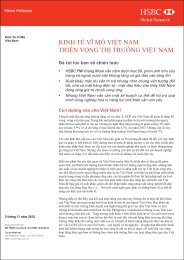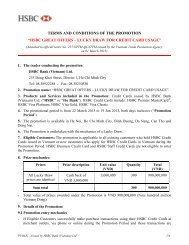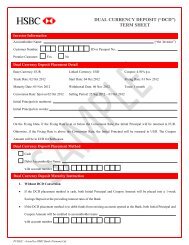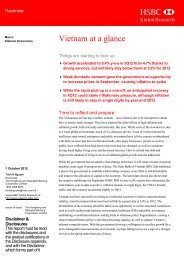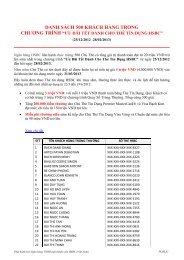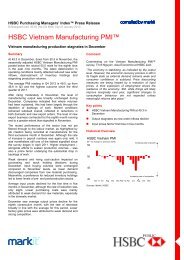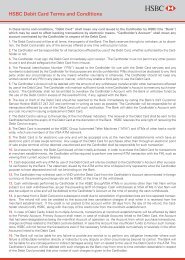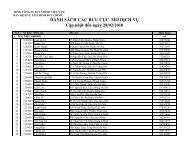2013 : Vietnam at a glance - HSBC
2013 : Vietnam at a glance - HSBC
2013 : Vietnam at a glance - HSBC
Create successful ePaper yourself
Turn your PDF publications into a flip-book with our unique Google optimized e-Paper software.
Economics<br />
Macro - <strong>Vietnam</strong><br />
abc<br />
Global Research<br />
<strong>Vietnam</strong> <strong>at</strong> a <strong>glance</strong><br />
Starting with a stronger found<strong>at</strong>ion<br />
The economy slowed as expected to<br />
5.0% in 2012 from 5.9% the previous<br />
year, but the sacrifice was not in vain<br />
From a macro perspective, <strong>2013</strong> will<br />
likely be a better year than 2012 amid<br />
slowly improving domestic and<br />
external demand and the initial results<br />
from <strong>Vietnam</strong>’s recent reform efforts<br />
W<strong>at</strong>ch out for further concrete reforms,<br />
especially those th<strong>at</strong> reduce bad debt<br />
in the financial system and improve the<br />
business environment to make <strong>Vietnam</strong><br />
more competitive<br />
2 January <strong>2013</strong><br />
Trinh D Nguyen<br />
Economist<br />
The Hongkong and Shanghai Banking Corpor<strong>at</strong>ion Limited<br />
+852 2996 6975 trinhdnguyen@hsbc.com.hk<br />
View <strong>HSBC</strong> Global Research <strong>at</strong>: http://www.research.hsbc.com<br />
Issuer of report: The Hongkong and Shanghai Banking<br />
Corpor<strong>at</strong>ion Limited<br />
Disclaimer & Disclosures<br />
This report must be read with the<br />
disclosures and the analyst certific<strong>at</strong>ions<br />
in the Disclosure appendix, and with the<br />
Disclaimer, which forms part of it<br />
More needs to be done<br />
For a country with gre<strong>at</strong> potential such as <strong>Vietnam</strong>, the 5%<br />
growth of 2012 is nothing to cheer about, as this is not fast<br />
enough to allow the country to leap to a new level of<br />
development. But this number should be interpreted in the<br />
context of <strong>Vietnam</strong>’s past, current and future challenges.<br />
Since transforming the country into a more market-oriented<br />
economy from a centrally planned one in the l<strong>at</strong>e 1980s and<br />
early 1990s, <strong>Vietnam</strong> has grown on average 7%. Thanks to<br />
reforms such as strengthened property rights, market<br />
liberaliz<strong>at</strong>ion and opening to foreign investment, <strong>Vietnam</strong><br />
boosted productivity significantly in the 1990s. But this<br />
burst of total factor productivity gradually slowed in the<br />
2000s as st<strong>at</strong>e investment rose significantly. And much of<br />
this st<strong>at</strong>e investment was not in efficiently run st<strong>at</strong>e-owned<br />
enterprises, which required more capital to subsidise their<br />
oper<strong>at</strong>ions. As such, the strong growth r<strong>at</strong>es in the past<br />
decade were not sustainable, as the costs were<br />
macroeconomic instability and lower productivity.<br />
Therefore, the government’s actions in 2011 and 2012 to<br />
prioritise sustained – over rapid – growth were considered<br />
positive for <strong>Vietnam</strong>’s long-term outlook.<br />
But further reforms are needed and the sooner they come,<br />
the better. The bad debt overhang still needs to be resolved.<br />
The business environment and supportive infrastructure<br />
should be improved. <strong>Vietnam</strong>, while <strong>at</strong>tractive for its<br />
burgeoning market and cheap wages, is either stagn<strong>at</strong>ing or<br />
worsening in major competitiveness rankings. Although the<br />
contraction of registered FDI inflows is partly due to<br />
sluggish global growth, it also reflects <strong>Vietnam</strong>’s gradual<br />
loss of competitiveness.
Economics<br />
Macro - <strong>Vietnam</strong><br />
2 January <strong>2013</strong><br />
abc<br />
Chart 1. Growth slowed in 2012; the industry sector saw the<br />
biggest decline (% y-o-y)<br />
9<br />
7<br />
5<br />
3<br />
1<br />
-1<br />
Dec-08 Jun-09 Dec-09 Jun-10 Dec-10 Jun-11 Dec-11 Jun-12 Dec-12<br />
Agriculture<br />
Industry<br />
Manufacturing<br />
Services<br />
Source: CEIC, <strong>HSBC</strong><br />
Despite a challenging year, some bright stars of the<br />
economy shone in 2012. Exports expanded almost<br />
20% despite weak external demand. There was a<br />
trade surplus. The December <strong>HSBC</strong> PMI<br />
employment sub-index rose. Investment from Japan<br />
increased, reflecting the still <strong>at</strong>tractive workforce and<br />
loc<strong>at</strong>ion. But whether these will stay strong depends<br />
on how soon reforms come. We remain w<strong>at</strong>chful of<br />
the concrete actions the government takes.<br />
Chart 2. But on a quarter-on-quarter seasonally adjusted<br />
basis, the economy is stabilizing and on track for a recovery,<br />
albeit a modest one (% q-o-q sa)<br />
5<br />
3<br />
1<br />
-1<br />
-3<br />
-5<br />
Dec-08 Jun-09 Dec-09 Jun-10 Dec-10 Jun-11 Dec-11 Jun-12 Dec-12<br />
Source: CEIC, <strong>HSBC</strong><br />
Agriculture Industry Services<br />
A better but still bumpy year<br />
With cautious optimism, we expect <strong>2013</strong> to be a<br />
better year than 2012. Across the globe, monetary<br />
officials are doing wh<strong>at</strong> they can to shore up<br />
domestic demand. Japan, an important market for<br />
<strong>Vietnam</strong>ese exporters, will likely see upside risks<br />
to GDP growth thanks to Prime Minister Abe’s<br />
accommod<strong>at</strong>ive stance as well as the BOJ’s<br />
aggressive easing. D<strong>at</strong>a from the US also suggests<br />
th<strong>at</strong> the housing recovery is real, which means<br />
th<strong>at</strong> consumer confidence will likely be supported<br />
(though w<strong>at</strong>ch the lingering fiscal cliff concerns).<br />
Coupled with this, the FOMC is doing wh<strong>at</strong> it can<br />
to help the US economy. China is on track for an<br />
economic recovery and bumps in the road will<br />
Chart 3. The manufacturing sector is recovering, thanks to<br />
slowing infl<strong>at</strong>ion, stabiliz<strong>at</strong>ion of domestic demand and a<br />
China recovery<br />
5<br />
3<br />
1<br />
-1<br />
-3<br />
-5<br />
Sep-11 Dec-11 Mar-12 Jun-12 Sep-12 Dec-12<br />
Source: CEIC, Markit, <strong>HSBC</strong><br />
<strong>HSBC</strong> PMI Index (% 3m/3m)<br />
Official GDP Manufacturing (% QoQ sa)<br />
Chart 4. Sluggish growth in the developed world, especially<br />
the EU, caused demand for goods such as textiles and<br />
footwear to slow; but new foreign investment in electronics<br />
helped boosted exports to double digits (% y-o-y)<br />
60<br />
40<br />
20<br />
0<br />
-20<br />
-40<br />
Source: CEIC, <strong>HSBC</strong><br />
2007 2008 2009 2010 2011 2012<br />
Electronics Textile & Garments<br />
Crude Oil<br />
Total<br />
2
Economics<br />
Macro - <strong>Vietnam</strong><br />
2 January <strong>2013</strong><br />
abc<br />
Chart 5. Since June 2010, export growth has exceeded<br />
import growth on a quarterly basis (% y-o-y), allowing the<br />
trade deficit to narrow…<br />
40<br />
30<br />
20<br />
10<br />
0<br />
-10<br />
-20<br />
-30<br />
-40<br />
Dec-08 Sep-09 Jun-10 Mar-11 Dec-11 Sep-12<br />
Source: CEIC, <strong>HSBC</strong><br />
Exports<br />
Imports<br />
Chart 6. …thanks to a refocus on manufacturing;<br />
manufacturing FDI inflows in 2012 (% of total registered FDI)<br />
60<br />
50<br />
40<br />
30<br />
20<br />
10<br />
0<br />
Electricity, Gas, Air<br />
Con Supply<br />
Source: CEIC, <strong>HSBC</strong><br />
Human Health<br />
Construction<br />
Transport<strong>at</strong>ion<br />
Inform<strong>at</strong>ion,<br />
Communic<strong>at</strong>ion<br />
Wholesale, Retail<br />
Trade, Motor Repair<br />
Real Est<strong>at</strong>e Activities<br />
Manufacturing<br />
likely be smoothed out with fiscal policy. The EU,<br />
the biggest market for <strong>Vietnam</strong>, may have<br />
bottomed out in Q4 2012.<br />
This means th<strong>at</strong> from an expenditure perspective,<br />
external demand for <strong>Vietnam</strong>ese goods is<br />
expected to improve. Exports, while still strong <strong>at</strong><br />
18.3% growth, slowed from 34.2% in 2011. Most<br />
of the slowdown was in textiles, garments and<br />
footwear, which dropped significantly due to<br />
weaker demand in the EU. But thanks to new<br />
foreign investment in electronics, which raised<br />
electronic exports, the total export level remained<br />
robust. The growth r<strong>at</strong>e of electronics will likely<br />
slow, although should still remain strong, as the<br />
one-time burst of new investment wears off. The<br />
acceler<strong>at</strong>ion of non-electronic exports should<br />
offset the neg<strong>at</strong>ive effect of both slowing<br />
electronics and likely decline in crude exports due<br />
to increased capability in oil refinery th<strong>at</strong> raises<br />
domestic demand for crude oil (and limits import<br />
needs of refined products).<br />
From a sector outlook, manufacturing is poised to<br />
benefit from firmer demand from abroad as well as<br />
contained infl<strong>at</strong>ion, which gives scope for<br />
manufacturers to employ price discounting<br />
str<strong>at</strong>egies. The sector had a tough year in 2012, as<br />
domestic demand was subdued and external<br />
demand weakened. But moving forward, we<br />
expect the global landscape to improve. Even<br />
domestically, after two years of tightening their<br />
purses, consumers are gradually easing. Chart 3<br />
shows th<strong>at</strong> the <strong>HSBC</strong> PMI manufacturing index<br />
tracks well with the official GDP breakdown of<br />
manufacturing growth, although the <strong>HSBC</strong> PMI<br />
Table 1. <strong>HSBC</strong> <strong>Vietnam</strong> Manufacturing PMI and its sub-indices<br />
Dec-12 Nov-12 Oct-12 Long-Term Average<br />
PMI Index 49.3 50.5 48.7 49.3<br />
Output 50.1 51.6 49.3 49.6<br />
New Orders 49.0 51.1 47.2 49.4<br />
New Export Orders 47.1 48.5 45.4 49.9<br />
Backlogs of Work 43.6 45.2 46.5 48.4<br />
Stocks of Finished Goods 47.4 46.9 50.2 49.6<br />
Employment 51.3 51.4 50.8 50.3<br />
Output Prices 45.5 46.6 47.5 51.1<br />
Input Prices 49.6 51.0 56.3 57.2<br />
Suppliers' Delivery Times 52.6 52.6 52.6 52.6<br />
Stocks of Purchases 44.2 45.8 45.6 47.7<br />
Quantity of Purchases 50.0 51.0 47.9 48.7<br />
Source: Markit, <strong>HSBC</strong>; Note: Less than 50 and falling Less than 50 and rising or same Gre<strong>at</strong>er than or equal to 50 and falling Gre<strong>at</strong>er or equal to 50 and rising or same<br />
3
Economics<br />
Macro - <strong>Vietnam</strong><br />
2 January <strong>2013</strong><br />
abc<br />
Chart 7. Activity is stable but still very bumpy due to...<br />
Chart 8. ...still weak global conditions and sluggish domestic<br />
demand (PMI-based index)<br />
60<br />
60<br />
55<br />
55<br />
50<br />
50<br />
45<br />
45<br />
40<br />
Mar-11 Jun-11 Sep-11 Dec-11 Mar-12 Jun-12 Sep-12 Dec-12<br />
PMI Index<br />
Output<br />
Source: Markit, <strong>HSBC</strong><br />
40<br />
Mar-11 Jun-11 Sep-11 Dec-11 Mar-12 Jun-12 Sep-12 Dec-12<br />
New Orders<br />
New Export Orders<br />
Source: Markit, <strong>HSBC</strong><br />
shows a sharper contraction in 3Q. Since 3Q,<br />
activities have been bolstered by improved<br />
domestic credit conditions as well as a gradual<br />
recovery of China. But with the global recovery<br />
process still fragile as well as the unresolved fiscal<br />
compromise in the US, 1Q could be a bumpy ride.<br />
The December <strong>HSBC</strong> PMI sub-indices show th<strong>at</strong><br />
manufacturing activity stabilised <strong>at</strong> close to 50 but<br />
has yet to take off, being held back by cautious<br />
consumption abroad and domestically. New export<br />
orders show a continued deterior<strong>at</strong>ion of external<br />
demand, which will likely persist into early 1Q.<br />
Note both the stabilis<strong>at</strong>ion of output as well as the<br />
expansion of employment despite persistent weak<br />
export demand. This reflects a gradual<br />
improvement of credit conditions domestically as<br />
well as slowing infl<strong>at</strong>ion (Chart 9), which gives<br />
room for manufacturers to discount output prices<br />
to boost demand. But a continued contraction of<br />
inventory suggests th<strong>at</strong> de-stocking measures are<br />
ongoing and managers are waiting for stronger<br />
signs of growth to ramp up production. While<br />
preparing for an expansion with increased<br />
employment, they are proceeding cautiously.<br />
The service sector, on the other hand, continues to<br />
be robust (Charts 1 and 2), albeit expanding by a<br />
slower pace of 6.4% in 2012 versus 8.2% in 2011.<br />
This resilience is derived from <strong>Vietnam</strong>’s strong<br />
demographics and rising income, which<br />
necessit<strong>at</strong>e a range of services from financials,<br />
transport, health, educ<strong>at</strong>ion and electronics repair.<br />
At the same juncture, the real est<strong>at</strong>e sector is<br />
Chart 9. Output prices continue to drop thanks to slowing<br />
infl<strong>at</strong>ion (PMI-based index)<br />
60<br />
55<br />
50<br />
45<br />
40<br />
Mar-11 Jun-11 Sep-11 Dec-11 Mar-12 Jun-12 Sep-12 Dec-12<br />
Source: Markit, <strong>HSBC</strong><br />
Output Prices<br />
Input Prices<br />
Chart 10. Employment continues to expand due to<br />
expect<strong>at</strong>ions of a recovery but manufacturers are still<br />
cautious and continuing to destock (PMI-based index)<br />
55<br />
54<br />
53<br />
52<br />
51<br />
50<br />
49<br />
48<br />
47<br />
46<br />
45<br />
Mar-11 Jun-11 Sep-11 Dec-11 Mar-12 Jun-12 Sep-12 Dec-12<br />
Source: Markit, <strong>HSBC</strong><br />
Stocks of Finished Goods<br />
Employment<br />
4
Economics<br />
Macro - <strong>Vietnam</strong><br />
2 January <strong>2013</strong><br />
abc<br />
Chart 11 Slowing GDP growth has hurt revenue collection,<br />
although lower public spending helps the budget balance to<br />
narrow<br />
% y-o-y VND bn<br />
45<br />
100000<br />
35<br />
25<br />
15<br />
5<br />
-5<br />
2006 2007 2008 2009 2010 2011 2012<br />
Source: CEIC, <strong>HSBC</strong><br />
Current spending<br />
Budget balance (RHS)<br />
Revenue: Tax<br />
80000<br />
60000<br />
40000<br />
20000<br />
0<br />
-20000<br />
-40000<br />
Chart 12. Infl<strong>at</strong>ion is expected to be rel<strong>at</strong>ively contained in<br />
<strong>2013</strong> with a modest pickup due to improved demand and an<br />
unfavourable base effect<br />
27<br />
22<br />
17<br />
12<br />
7<br />
2<br />
Nov-07 Oct-08 Sep-09 Aug-10 Jul-11 Jun-12 May-13<br />
Source: CEIC, <strong>HSBC</strong><br />
Headline CPI (% y-o-y)<br />
<strong>HSBC</strong><br />
Forecasts<br />
Core CPI (% y-o-y)<br />
particularly affected by the slowdown<br />
domestically as bad debts have not been cleared.<br />
As such, the sector is rel<strong>at</strong>ively frozen as the<br />
process for recovering insolvency is cumbersome<br />
and banks prefer to roll over bad debts. This<br />
means is th<strong>at</strong> unless the issue of bad debt is<br />
resolved, a recalibr<strong>at</strong>ion of prices, in which the<br />
supply of real est<strong>at</strong>e would reflect demand, is<br />
unlikely to happen. The St<strong>at</strong>e Bank of <strong>Vietnam</strong><br />
(SBV) hopes to address this by setting aside<br />
VND20-40trn to lend to home buyers in <strong>2013</strong> to<br />
boost the property market. Should it be successful<br />
<strong>at</strong> boosting demand for real est<strong>at</strong>e, the issue of<br />
existing bad debts would be largely untouched,<br />
which means systemic risks would remain if not<br />
become larger. Given th<strong>at</strong> banks are more<br />
cautious and are quality credit-driven, any new<br />
lending would be contingent upon the availability<br />
of credit-worthy borrowers. As such, we do not<br />
anticip<strong>at</strong>e a huge upsurge of credit growth in<br />
<strong>2013</strong>. The SBV estim<strong>at</strong>es th<strong>at</strong> credit growth will<br />
acceler<strong>at</strong>e to 12% in <strong>2013</strong> from 6.4% in 2012,<br />
which is close to our forecast of 13%. Taking<br />
infl<strong>at</strong>ion into account, real credit should only give<br />
a marginal boost to growth.<br />
The fiscal prints for the year reflect weak<br />
domestic demand; the budget deficit declined to<br />
VND16trn from VND54.4trn in 2011 largely due<br />
to a decline in revenues and expenditures.<br />
Revenues from land and housing dropped 24.7%<br />
in 2012 while revenue from VAT imports<br />
Chart 13. The global slump and <strong>Vietnam</strong>’s slowing growth<br />
affected inflow FDI, although Japanese inflows remain<br />
strong (% y-o-y)<br />
1900<br />
1400<br />
900<br />
400<br />
-100<br />
Source: CEIC, <strong>HSBC</strong><br />
2010 2011 2012<br />
Japan South Korea Hong Kong Singapore<br />
Chart 14. Japan is the largest FDI investor in <strong>Vietnam</strong><br />
totalling USD4bn (% of total; top five FDI countries)<br />
80<br />
60<br />
40<br />
20<br />
0<br />
2008 2009 2010 2011 2012<br />
China Singapore Hong Kong South Korea Japan<br />
Source: CEIC, <strong>HSBC</strong><br />
5
Economics<br />
Macro - <strong>Vietnam</strong><br />
2 January <strong>2013</strong><br />
abc<br />
Chart 15. The slowdown of investment from top countries<br />
(except Japan) reflect deterior<strong>at</strong>ing competitiveness; a<br />
higher number indic<strong>at</strong>es a worse ranking<br />
2012<br />
2011<br />
2010<br />
0 20 40 60 80 100 120<br />
Doing business (WB) Infrastructure (WEF) Global competitive (WEF)<br />
Source: The World Bank, World Economic Forum, <strong>HSBC</strong><br />
Chart 16. Still has a lot of advantages, including strong<br />
popul<strong>at</strong>ion growth which could expand to 100m people in the<br />
mid 2020s (% working popul<strong>at</strong>ion growth r<strong>at</strong>e)<br />
2.5<br />
2.0<br />
1.5<br />
1.0<br />
0.5<br />
0.0<br />
-0.5<br />
-1.0<br />
Source: UN, <strong>HSBC</strong><br />
JP TW KR CH TH VN ID<br />
1990s 2000s 2010s 2020s<br />
contracted 3.2%. With the economy slowing<br />
down across the board, revenue collection from<br />
corpor<strong>at</strong>e income tax slowed to 16% from 24.5%<br />
in 2012; and VAT tax collection slowed to 10.4%<br />
from 26.1% in 2011. This transl<strong>at</strong>es into total<br />
revenue collected reducing to 10.8% from 24.3%<br />
in 2011. To carry out its fiscal consolid<strong>at</strong>ion<br />
policy, the government reined in public spending,<br />
which slowed to 18.9% from 35.5% in 2011.<br />
Capital expenditure saw a modest contraction.<br />
This is to lower the budget deficit as well as a cutdown<br />
on wasteful public spending. We expect this<br />
trend to continue next year with import growth<br />
still constrained by rel<strong>at</strong>ively weak domestic<br />
demand, albeit with some improvement in<br />
revenue collection as imports are expected to<br />
stage a modest recovery. With revenue collection<br />
slowing and expenditure reduced to lower the<br />
budget balance, a fiscal stimulus to spur growth is<br />
unlikely in <strong>2013</strong>, with the government having<br />
neither the funds nor the appetite to do so.<br />
As a whole, although growth slowed, five major<br />
developments were considered positive in 2012<br />
th<strong>at</strong> will eventually build a found<strong>at</strong>ion for more<br />
sustainable growth: 1) the trade balance is in<br />
surplus thanks to weaker import growth and<br />
strong exports; 2) infl<strong>at</strong>ion slowed to 6.8% in<br />
December 2012 from 17.8% in January 2012; 3)<br />
the budget deficit is narrowing, lowering<br />
<strong>Vietnam</strong>’s debt burden; 4) FX reserves have risen<br />
significantly; and 5) FDI inflows surged from<br />
Japan, which is considered positive for <strong>Vietnam</strong>’s<br />
industrializ<strong>at</strong>ion process.<br />
Chart 13 shows th<strong>at</strong> registered FDI inflows into<br />
<strong>Vietnam</strong> from Japan surged. The amount of<br />
Japanese FDI inflows into a country can also be a<br />
proxy on whether th<strong>at</strong> country would ultim<strong>at</strong>ely<br />
raise its level of productivity and move up the<br />
value chain. Generally speaking, Japanese FDI<br />
has been more “trade oriented” than US FDI,<br />
meaning Japanese firms in Asia tend to build<br />
overseas production zones as an extension of their<br />
domestic base. This results in Japanese firms<br />
having a role of being an initi<strong>at</strong>or and coach in the<br />
industrializ<strong>at</strong>ion of less-developed countries. In<br />
<strong>Vietnam</strong>, the top-five FDI countries are from<br />
Asia, which reflects an ongoing trend of<br />
multin<strong>at</strong>ional firms reloc<strong>at</strong>ing out of China to<br />
reduce costs. Countries, such as <strong>Vietnam</strong> and<br />
Indonesia, are poised to gain from this<br />
restructuring as labour costs are rel<strong>at</strong>ively lower<br />
and the popul<strong>at</strong>ion is dynamic enough to support<br />
robust domestic demand (Chart 16).<br />
However, <strong>Vietnam</strong> could do more to <strong>at</strong>tract<br />
foreign investment to support its development. As<br />
shown, with the fiscal space constrained, more<br />
foreign investment is needed to pick up the slack<br />
of domestic investment. Additionally, the<br />
6
Economics<br />
Macro - <strong>Vietnam</strong><br />
2 January <strong>2013</strong><br />
abc<br />
Table 2. <strong>HSBC</strong> main <strong>Vietnam</strong> forecasts<br />
Q1 2012 Q2 2012 Q3 2012 Q4 2012 Q1 <strong>2013</strong>f Q2 <strong>2013</strong>f Q3 <strong>2013</strong>f Q4 <strong>2013</strong>f 2011 2012 <strong>2013</strong>f<br />
GDP (% y-o-y) 4.1 4.7 5.4 5.5 7.5 5.5 4.5 4.7 5.9 5.0 5.5<br />
CPI, average (% y-o-y) 17.2 11.0 5.9 6.8 7.2 9.6 11.1 9.9 18.6 9.3 9.5<br />
Trade balance (% GDP) 0.9 -1.1 0.9 0.3 -4.6 -0.5 1.3 0.8 -9.8* 0.2* -2.2*<br />
OMO r<strong>at</strong>e, end quarter (%) 13.0 10.0 8.0 7.0 7.0 7.0 7.0 8.0 14.0 7.0 8.0<br />
VND/USD, end quarter 20900 20905 20860 20900 21000 21000 21500 21500 21034 20900 21500<br />
Source: CEIC, <strong>HSBC</strong>; Note * denotes USDbn<br />
infrastructure needs are immense, ranging from<br />
shortages of electricity to public transport<strong>at</strong>ion<br />
systems, which would benefit from world-class<br />
technology th<strong>at</strong> foreign firms bring. But to do this,<br />
<strong>Vietnam</strong> would need to improve its business<br />
environment, most notably reducing red tape and<br />
cre<strong>at</strong>ing clearer laws on how to resolve<br />
insolvency. Without doing so, firms are entering<br />
<strong>Vietnam</strong> only to take advantage of the wage costs<br />
r<strong>at</strong>her than to take advantage of the dynamic<br />
domestic market. This shows in the contraction of<br />
registered FDI (with the exception of Japan) as<br />
they have other <strong>at</strong>tractive markets such as<br />
Indonesia and Thailand to enter.<br />
As such, for <strong>Vietnam</strong> to realize its ambitions,<br />
reforms need to be carried out to not only<br />
elimin<strong>at</strong>e the bad debt but also improve the<br />
efficiency of the economy.<br />
7
Economics<br />
Macro - <strong>Vietnam</strong><br />
2 January <strong>2013</strong><br />
abc<br />
Disclosure appendix<br />
Analyst Certific<strong>at</strong>ion<br />
The following analyst(s), economist(s), and/or str<strong>at</strong>egist(s) who is(are) primarily responsible for this report, certifies(y) th<strong>at</strong> the<br />
opinion(s) on the subject security(ies) or issuer(s) and/or any other views or forecasts expressed herein accur<strong>at</strong>ely reflect their<br />
personal view(s) and th<strong>at</strong> no part of their compens<strong>at</strong>ion was, is or will be directly or indirectly rel<strong>at</strong>ed to the specific<br />
recommend<strong>at</strong>ion(s) or views contained in this research report: Trinh Nguyen<br />
Important Disclosures<br />
This document has been prepared and is being distributed by the Research Department of <strong>HSBC</strong> and is intended solely for the<br />
clients of <strong>HSBC</strong> and is not for public<strong>at</strong>ion to other persons, whether through the press or by other means.<br />
This document is for inform<strong>at</strong>ion purposes only and it should not be regarded as an offer to sell or as a solicit<strong>at</strong>ion of an offer<br />
to buy the securities or other investment products mentioned in it and/or to particip<strong>at</strong>e in any trading str<strong>at</strong>egy. Advice in this<br />
document is general and should not be construed as personal advice, given it has been prepared without taking account of the<br />
objectives, financial situ<strong>at</strong>ion or needs of any particular investor. Accordingly, investors should, before acting on the advice,<br />
consider the appropri<strong>at</strong>eness of the advice, having regard to their objectives, financial situ<strong>at</strong>ion and needs. If necessary, seek<br />
professional investment and tax advice.<br />
Certain investment products mentioned in this document may not be eligible for sale in some st<strong>at</strong>es or countries, and they may<br />
not be suitable for all types of investors. Investors should consult with their <strong>HSBC</strong> represent<strong>at</strong>ive regarding the suitability of<br />
the investment products mentioned in this document and take into account their specific investment objectives, financial<br />
situ<strong>at</strong>ion or particular needs before making a commitment to purchase investment products.<br />
The value of and the income produced by the investment products mentioned in this document may fluctu<strong>at</strong>e, so th<strong>at</strong> an<br />
investor may get back less than originally invested. Certain high-vol<strong>at</strong>ility investments can be subject to sudden and large falls<br />
in value th<strong>at</strong> could equal or exceed the amount invested. Value and income from investment products may be adversely<br />
affected by exchange r<strong>at</strong>es, interest r<strong>at</strong>es, or other factors. Past performance of a particular investment product is not indic<strong>at</strong>ive<br />
of future results.<br />
Analysts, economists, and str<strong>at</strong>egists are paid in part by reference to the profitability of <strong>HSBC</strong> which includes investment<br />
banking revenues.<br />
For disclosures in respect of any company mentioned in this report, please see the most recently published report on th<strong>at</strong><br />
company available <strong>at</strong> www.hsbcnet.com/research.<br />
* <strong>HSBC</strong> Legal Entities are listed in the Disclaimer below.<br />
Additional disclosures<br />
1 This report is d<strong>at</strong>ed as <strong>at</strong> 02 January <strong>2013</strong>.<br />
2 All market d<strong>at</strong>a included in this report are d<strong>at</strong>ed as <strong>at</strong> 1000 HKT 02 January <strong>2013</strong>, unless otherwise indic<strong>at</strong>ed in the report.<br />
3 <strong>HSBC</strong> has procedures in place to identify and manage any potential conflicts of interest th<strong>at</strong> arise in connection with its<br />
Research business. <strong>HSBC</strong>'s analysts and its other staff who are involved in the prepar<strong>at</strong>ion and dissemin<strong>at</strong>ion of Research<br />
oper<strong>at</strong>e and have a management reporting line independent of <strong>HSBC</strong>'s Investment Banking business. Inform<strong>at</strong>ion Barrier<br />
procedures are in place between the Investment Banking and Research businesses to ensure th<strong>at</strong> any confidential and/or<br />
price sensitive inform<strong>at</strong>ion is handled in an appropri<strong>at</strong>e manner.<br />
8
Economics<br />
Macro - <strong>Vietnam</strong><br />
2 January <strong>2013</strong><br />
abc<br />
Disclaimer<br />
* Legal entities as <strong>at</strong> 8 August 2012<br />
‘UAE’ <strong>HSBC</strong> Bank Middle East Limited, Dubai; ‘HK’ The Hongkong and Shanghai Banking Corpor<strong>at</strong>ion<br />
Limited, Hong Kong; ‘TW’ <strong>HSBC</strong> Securities (Taiwan) Corpor<strong>at</strong>ion Limited; 'CA' <strong>HSBC</strong> Bank Canada,<br />
Toronto; <strong>HSBC</strong> Bank, Paris Branch; <strong>HSBC</strong> France; ‘DE’ <strong>HSBC</strong> Trinkaus & Burkhardt AG, Düsseldorf; 000<br />
<strong>HSBC</strong> Bank (RR), Moscow; ‘IN’ <strong>HSBC</strong> Securities and Capital Markets (India) Priv<strong>at</strong>e Limited, Mumbai; ‘JP’<br />
<strong>HSBC</strong> Securities (Japan) Limited, Tokyo; ‘EG’ <strong>HSBC</strong> Securities Egypt SAE, Cairo; ‘CN’ <strong>HSBC</strong> Investment<br />
Bank Asia Limited, Beijing Represent<strong>at</strong>ive Office; The Hongkong and Shanghai Banking Corpor<strong>at</strong>ion Limited,<br />
Singapore Branch; The Hongkong and Shanghai Banking Corpor<strong>at</strong>ion Limited, Seoul Securities Branch; The<br />
Hongkong and Shanghai Banking Corpor<strong>at</strong>ion Limited, Seoul Branch; <strong>HSBC</strong> Securities (South Africa) (Pty)<br />
Ltd, Johannesburg; <strong>HSBC</strong> Bank plc, London, Madrid, Milan, Stockholm, Tel Aviv; ‘US’ <strong>HSBC</strong> Securities<br />
(USA) Inc, New York; <strong>HSBC</strong> Y<strong>at</strong>irim Menkul Degerler AS, Istanbul; <strong>HSBC</strong> México, SA, Institución de Banca<br />
Múltiple, Grupo Financiero <strong>HSBC</strong>; <strong>HSBC</strong> Bank Brasil SA – Banco Múltiplo; <strong>HSBC</strong> Bank Australia Limited;<br />
<strong>HSBC</strong> Bank Argentina SA; <strong>HSBC</strong> Saudi Arabia Limited; The Hongkong and Shanghai Banking Corpor<strong>at</strong>ion<br />
Limited, New Zealand Branch incorpor<strong>at</strong>ed in Hong Kong SAR<br />
Issuer of report<br />
The Hongkong and Shanghai<br />
Banking Corpor<strong>at</strong>ion Limited<br />
Level 19, 1 Queen's Road Central<br />
Hong Kong SAR<br />
Telephone: +852 2843 9111<br />
Telex: 75100 CAPEL HX<br />
Fax: +852 2801 4138<br />
Website: www.research.hsbc.com<br />
The Hongkong and Shanghai Banking Corpor<strong>at</strong>ion Limited (“<strong>HSBC</strong>”) has issued this research m<strong>at</strong>erial. The Hongkong and Shanghai Banking Corpor<strong>at</strong>ion<br />
Limited is regul<strong>at</strong>ed by the Hong Kong Monetary Authority. This m<strong>at</strong>erial is distributed in the United Kingdom by <strong>HSBC</strong> Bank plc. In Australia, this<br />
public<strong>at</strong>ion has been distributed by The Hongkong and Shanghai Banking Corpor<strong>at</strong>ion Limited (ABN 65 117 925 970, AFSL 301737) for the general<br />
inform<strong>at</strong>ion of its “wholesale” customers (as defined in the Corpor<strong>at</strong>ions Act 2001). Where distributed to retail customers, this research is distributed by<br />
<strong>HSBC</strong> Bank Australia Limited (AFSL No. 232595). These respective entities make no represent<strong>at</strong>ions th<strong>at</strong> the products or services mentioned in this<br />
document are available to persons in Australia or are necessarily suitable for any particular person or appropri<strong>at</strong>e in accordance with local law. No<br />
consider<strong>at</strong>ion has been given to the particular investment objectives, financial situ<strong>at</strong>ion or particular needs of any recipient.<br />
This public<strong>at</strong>ion is distributed in New Zealand by The Hongkong and Shanghai Banking Corpor<strong>at</strong>ion Limited, New Zealand Branch incorpor<strong>at</strong>ed in Hong<br />
Kong SAR.<br />
This m<strong>at</strong>erial is distributed in Japan by <strong>HSBC</strong> Securities (Japan) Limited. <strong>HSBC</strong> Securities (USA) Inc. accepts responsibility for the content of this research<br />
report prepared by its non-US foreign affili<strong>at</strong>e. All US persons receiving and/or accessing this report and intending to effect transactions in any security<br />
discussed herein should do so with <strong>HSBC</strong> Securities (USA) Inc. in the United St<strong>at</strong>es and not with its non-US foreign affili<strong>at</strong>e, the issuer of this report. In<br />
Korea, this public<strong>at</strong>ion is distributed by either The Hongkong and Shanghai Banking Corpor<strong>at</strong>ion Limited, Seoul Securities Branch ("HBAP SLS") or The<br />
Hongkong and Shanghai Banking Corpor<strong>at</strong>ion Limited, Seoul Branch ("HBAP SEL") for the general inform<strong>at</strong>ion of professional investors specified in Article<br />
9 of the Financial Investment Services and Capital Markets Act (“FSCMA”). This public<strong>at</strong>ion is not a prospectus as defined in the FSCMA. It may not be<br />
further distributed in whole or in part for any purpose. Both HBAP SLS and HBAP SEL are regul<strong>at</strong>ed by the Financial Services Commission and the<br />
Financial Supervisory Service of Korea. In Singapore, this public<strong>at</strong>ion is distributed by The Hongkong and Shanghai Banking Corpor<strong>at</strong>ion Limited, Singapore<br />
Branch for the general inform<strong>at</strong>ion of institutional investors or other persons specified in Sections 274 and 304 of the Securities and Futures Act (Chapter 289)<br />
(“SFA”) and accredited investors and other persons in accordance with the conditions specified in Sections 275 and 305 of the SFA. This public<strong>at</strong>ion is not a<br />
prospectus as defined in the SFA. It may not be further distributed in whole or in part for any purpose. The Hongkong and Shanghai Banking Corpor<strong>at</strong>ion<br />
Limited Singapore Branch is regul<strong>at</strong>ed by the Monetary Authority of Singapore. Recipients in Singapore should contact a "Hongkong and Shanghai Banking<br />
Corpor<strong>at</strong>ion Limited, Singapore Branch" represent<strong>at</strong>ive in respect of any m<strong>at</strong>ters arising from, or in connection with this report. In the UK this m<strong>at</strong>erial may<br />
only be distributed to institutional and professional customers and is not intended for priv<strong>at</strong>e customers. It is not to be distributed or passed on, directly or<br />
indirectly, to any other person. <strong>HSBC</strong> México, S.A., Institución de Banca Múltiple, Grupo Financiero <strong>HSBC</strong> is authorized and regul<strong>at</strong>ed by Secretaría de<br />
Hacienda y Crédito Público and Comisión Nacional Bancaria y de Valores (CNBV). <strong>HSBC</strong> Bank (Panama) S.A. is regul<strong>at</strong>ed by Superintendencia de Bancos<br />
de Panama. Banco <strong>HSBC</strong> Honduras S.A. is regul<strong>at</strong>ed by Comisión Nacional de Bancos y Seguros (CNBS). Banco <strong>HSBC</strong> Salvadoreño, S.A. is regul<strong>at</strong>ed by<br />
Superintendencia del Sistema Financiero (SSF). <strong>HSBC</strong> Colombia S.A. is regul<strong>at</strong>ed by Superintendencia Financiera de Colombia. Banco <strong>HSBC</strong> Costa Rica<br />
S.A. is supervised by Superintendencia General de Entidades Financieras (SUGEF). Banistmo Nicaragua, S.A. is authorized and regul<strong>at</strong>ed by<br />
Superintendencia de Bancos y de Otras Instituciones Financieras (SIBOIF).<br />
Any recommend<strong>at</strong>ions contained in it are intended for the professional investors to whom it is distributed. This m<strong>at</strong>erial is not and should not be construed as<br />
an offer to sell or the solicit<strong>at</strong>ion of an offer to purchase or subscribe for any investment. <strong>HSBC</strong> has based this document on inform<strong>at</strong>ion obtained from sources<br />
it believes to be reliable but which it has not independently verified; <strong>HSBC</strong> makes no guarantee, represent<strong>at</strong>ion or warranty and accepts no responsibility or<br />
liability as to its accuracy or completeness. Expressions of opinion are those of <strong>HSBC</strong> only and are subject to change without notice. The decision and<br />
responsibility on whether or not to invest must be taken by the reader. <strong>HSBC</strong> and its affili<strong>at</strong>es and/or their officers, directors and employees may have<br />
positions in any securities mentioned in this document (or in any rel<strong>at</strong>ed investment) and may from time to time add to or dispose of any such securities (or<br />
investment). <strong>HSBC</strong> and its affili<strong>at</strong>es may act as market maker or have assumed an underwriting commitment in the securities of any companies discussed in<br />
this document (or in rel<strong>at</strong>ed investments), may sell them to or buy them from customers on a principal basis and may also perform or seek to perform banking<br />
or underwriting services for or rel<strong>at</strong>ing to those companies. This m<strong>at</strong>erial may not be further distributed in whole or in part for any purpose. No consider<strong>at</strong>ion<br />
has been given to the particular investment objectives, financial situ<strong>at</strong>ion or particular needs of any recipient. (070905)<br />
In Canada, this document has been distributed by <strong>HSBC</strong> Bank Canada and/or its affili<strong>at</strong>es. Where this document contains market upd<strong>at</strong>es/overviews, or similar<br />
m<strong>at</strong>erials (collectively deemed “Commentary” in Canada although other affili<strong>at</strong>e jurisdictions may term “Commentary” as either “macro-research” or<br />
“research”), the Commentary is not an offer to sell, or a solicit<strong>at</strong>ion of an offer to sell or subscribe for, any financial product or instrument (including, without<br />
limit<strong>at</strong>ion, any currencies, securities, commodities or other financial instruments).<br />
© Copyright <strong>2013</strong>, The Hongkong and Shanghai Banking Corpor<strong>at</strong>ion Limited, ALL RIGHTS RESERVED. No part of this public<strong>at</strong>ion may be reproduced,<br />
stored in a retrieval system, or transmitted, on any form or by any means, electronic, mechanical, photocopying, recording, or otherwise, without the prior<br />
written permission of The Hongkong and Shanghai Banking Corpor<strong>at</strong>ion Limited. MICA (P) 038/04/2012, MICA (P) 063/04/2012 and MICA (P)<br />
206/01/2012<br />
9



